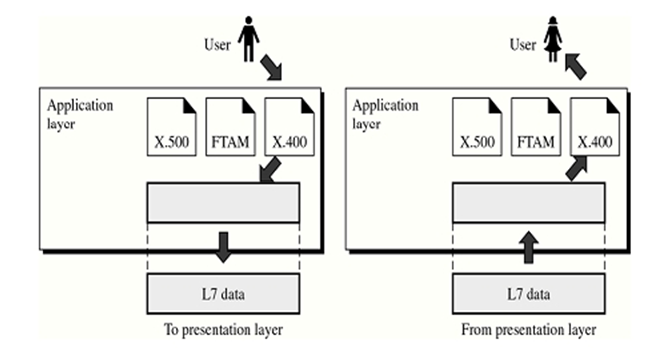™ Transport Layer
o Responsible for Source-to-Destination delivery of Entire Message
o Network Layer oversees source-to-destination delivery of the entire packets but it
does not recognize any relationship b/w those packets
o Network layer treats each packet independently
o Transport Layer ensures that whole message arrives at the destination intact
• Functions of Transport Layer
o Service Point Addressing
Computers run several programs at the same time
Source-to-Destination delivery means delivery not only from only from one
computer to the other but also from a specific process on one computer to a
specific process on the other
Transport layer header includes a type of address called Service Point Address
or PORT Address
Network layer each packet to the correct computer while Transport layer gets
entire message to the correct process on that comuter
o Segmentation and Reassembly
Message is divided into transmittable segments
Each segment contains a sequence number
These sequence no.s enable Transport layer at the receiving m/c to reassemble
message correctly at the destination and to identify and replace lost packets
|
o Connection Control
Transport layer can be either connection-less or connection-oriented
Connectionless
|
Treats each segment as an independent packet and delivers it to the
transport layer of the destination m/c
Connection-Oriented
A connection is established first with Transport layer before
delivering the packet.
After all data is Tx. , the connection is disconnected
o Flow Control
¾ Like Data link layer, Transport layer is also responsible for Flow control
¾ Flow control is performed end-to-end rather than across a single link
o Error Control
Like data link layer, Transport layer is responsible for the Error Control
Error control is performed end-to-end
This layer makes sure that entire message reaches Rx Transport layer w/o
error
Error can be a result of Lost, damaged or duplicated data and usually Re Tx is
done
|
|
|

™ Session Layer
o Session layer is the Network Dialog Controller
o Establishes, Maintains, and Synchronizes the interaction between communicating systems
|
• Function of Session Layer
o Dialog Control
Session layer allows two systems to enter into a dialog.
It allows communication between two processes to take place either in half
duplex or full duplex mode
o Synchronization
Session layer allows a process to add check points (synchronization points)
in a stream of data
If a system is sending a file of 2000 pages, it is advisable to insert check
points after every 100 page to ensure that each 100 page unit is received
and acknowledged independently
In this case, if a crash happens during the transmission of page 523 ,
retransmission at page 501
Page 1-500 need not be retransmitted
™ Presentation Layer
o This layer is concerned with Syntax and Semantics of info exchange between
two systems
|

Functions of Presentation Layer
o Translation
The processes (running programs) in two systems are usually exchanging
info in the form of character strings, numbers and so on¼..
The info should be changed to bit streams before being transmitted
Because different computers use different ENCODING SYSTEMS,
presentation layer is responsible for interoperability b/w these different
encoding methods
The presentation layer at the sender changes the info from its sender-
dependent format to the common format
The presentation at the receiver changes info from common to the receiver
dependent format
o Encryption
To carry sensitive info , a system must be able to assure privacy
Encryption means that sender transforms original info to another form and
sends the resulting message out over the network
Decryption reverses the original process to transform message back to its
original form
o Compression
|
Data compression reduces the number of bits to be transmitted
Data compression becomes particularly important in transmission of
multimedia such as text, audio and video
™ Application Layer
o Enables the user either human or software to access the network
o It provides user interface and support for the services such as Electronic mail,
Remote File access and Transfer, Shared Database Management and other
services
Application Layer Figure
o In the figure, of many application services available, only three services are
shown
-X-400 (message Handling Services)
-X-500 (Directory Services)
-File Transfer, Access& Management (FTAM)
o In this example user uses X-400 to send an e-mail message
o No headers or trailers are added at this layer
• Application Layer Functions
Network Virtual Terminal
o NVT is a software version of a physical terminal and allows a user to log on to
a remote host
o To do so the application created emulation of terminal at the remote host
o Users computer talks to the software terminal which in turn talks to the host
*& vice versa
o Remote host believes it is communication with one of its own terminals and
allow you to log on
|
File Transfer, Access & Manage.(FTAM)
o This application allows a user to access file on the remote computers to make
changes or read data
o The purpose of this access is to Retrieve files from a remote computer and to
manage or control files in that remote computer
Mail Services
o This application provides the basis for email forwarding and storage
Directory Services
o Provides distributed database sources and access for global info about various
objects and services
|
|
|





No comments:
Post a Comment